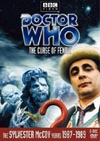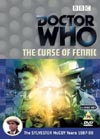DVD Features include:
VHS Features include:
The Doctor and Ace themselves get the bare minimum of introduction in this tale. The TARDIS makes next to no impact on the adventure, merely depositing our characters into the setting with a decent materialization, and then getting completely ignored afterwards. It probably would be an improvement to establish exactly why they chose to come here. Early episodes can kind of get away without it if you assume they arrived randomly and simply wanted to explore where they are, as often happened in the Patrick Troughton era. However, both the level of precise geographical knowledge displayed in their opening dialogue, not to mention later developments in the story, added to the fact that Ace has already made the effort to dress for the period, all make it much more likely that this landing was an enigmatic choice. As it stands anyway, their early scenes are so enjoyable, and so easily understandable, that one forgives this fairly readily. The balance between creating mystery vs. creating confusion has been much, much better looked after in this script. While there is little doubt that this adventure stands out positively in McCoy's era, it still remains shy of some elements that previous Doctors' eras thrived on. As we encounter strange phenomena here in "The Curse of Fenric", it seems little is done to establish credible scientific theories behind this, or in fact use scientifically plausible reasoning to explain the plot mechanisms that our bizarre new antagonistic forces must work through and/or can use to attain their goals. The story is much more focused on a sort of magical folklore. It doesn't quite beg for more explanation to the same degree as most of the other candy-horror stories of this era that try to set up shop in the real world instead of a mental dimension. "The Curse of Fenric" isn't really in candy-horror territory, but is probably sitting somewhere not too far from the border. And, I have to give the story a lot of points for the idea of the psychic energy of faith becoming one of the story's major mechanisms here. Even if a reason for the Haemovores' response to it is still a bit vague, it's every bit as cool as most of the uses of mental powers that we saw back in season twenty, while partly triumphing in finding the "better way" that seemed to elude the violence-fests of season twenty-one and beyond. While a hint of the old passive-aggressive syndrome peaks through, particularly with Dr. Judson, such things are the tools of the villains and aren't powerful enough to overshadow the other interesting dynamics at play here. It does become clear that aiming for horror and fears and scares is one of the aims of the script, and not one that I am ever particularly impressed with. However, the success here is that it is only one of many goals, and it never quite overpowers the more prominent explorative ideas like code-breaking and seeking to understand curses, histories, cultures, and character motivations. In fact the tapestry remains quite rich as we get a mix of 1940's English, Russian, and German culture, added to which is a lot of ancient Viking. Writer Ian Briggs does a lot of research to make all of this come alive in his script, along with some clever mathematical and computer concepts to give it all a fascinating lift.
For the most part, the story's prosthetic masks work fairly well. The Ancient Haemovore isn't quite up to the same level as the Destroyer from "Battlefield" (story no. 156), particularly in giving a convincing lip-sync for his dialogue, but in the end he turns out to be more emotive anyway and a more interesting character. The concluding dynamics are worth noting, in some ways reflecting "Return of the Jedi" and similarly aiming for high ideals while falling a bit short, but this story gives the Doctor a more proactive "final fix" than what Luke Skywalker had. There is a lot of action amongst the troops, and without the audience really being able to root for either side, but this is okay since it is partly a story point. I must confess that no matter how many times I see this one, I still find it nearly impossible to understand what is actually motivating Commander Millington.... no matter how many layers one peels off of his onion, he still seems to be a few too many cards short of a full deck. That's not entirely a bad thing, but it doesn't feel like that was all that was intended. Interesting too is the way gratuitous references to details of previous McCoy stories crop up in the climactic dialogue, almost giving this story the same artificial sense of importance as a Russell T. Davies season finale. I think we can see here where another modern pattern actually began. At least "Logopolis" (story no. 116) wrapped up its season with more tangible extensions of elements from its other stories. Curiously, this story's coda begins with Ace needing to resolve one issue in the field, and then switches to another issue at the seaside, which she apparently resolves in a rather wet and unconvincing manner that doesn't take this member of the audience along with her. Weird... but it doesn't really spoil an adventure that otherwise works quite well.
International Titles:Deutsch: "Die Todesbucht der Wikinger"Magyar: "Fenric átka"Français: (La malédiction de Fenric)Русский: "Проклятие Фенрика"The Germans went back to the water's edge for their title for this adventure, settling on "The Death-Bay of the Vikings".
This story is available on DVD and VHS video. Click on the Amazon symbol for the location nearest you for pricing and availability:
Comments on this article are welcome. You may contact the author from this page:
|










